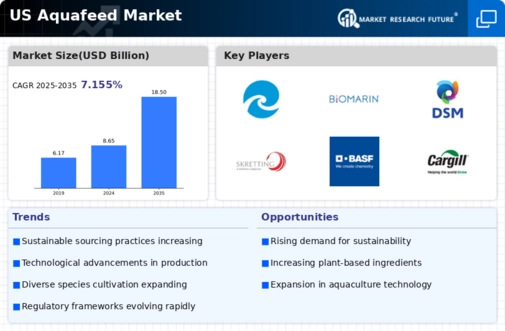Rising Demand for Seafood
The aquafeed market in the US is experiencing a notable increase in demand for seafood products. This trend is driven by a growing consumer preference for protein-rich diets, particularly those that include fish and shellfish. According to recent data, seafood consumption in the US has risen by approximately 15% over the past five years. This surge in demand necessitates a corresponding increase in aquafeed production, as aquaculture operations strive to meet consumer needs. The aquafeed market is thus positioned to benefit from this rising demand, as producers seek to enhance feed formulations to support sustainable aquaculture practices while ensuring high-quality seafood supply.
Global Supply Chain Dynamics
The dynamics of The aquafeed market in the US. Fluctuations in the availability and pricing of raw materials, such as fishmeal and plant-based proteins, can impact feed production costs. Recent trends indicate that the prices of key ingredients have experienced volatility, which poses challenges for aquafeed manufacturers. The aquafeed market must navigate these supply chain complexities to maintain profitability while ensuring the availability of high-quality feeds. As a response, producers may explore alternative ingredients and sourcing strategies to mitigate risks associated with supply chain disruptions, thereby enhancing the resilience of the industry.
Regulatory Support for Aquaculture
The regulatory landscape in the US is increasingly supportive of aquaculture initiatives, which is positively impacting the aquafeed market. Government policies aimed at promoting sustainable aquaculture practices are encouraging investments in the sector. For instance, the USDA has allocated funding to support research and development in aquaculture, which includes advancements in aquafeed formulations. This regulatory support is likely to enhance the growth of the aquafeed market, as it fosters innovation and encourages the adoption of best practices among aquaculture producers. As a result, the industry may witness an uptick in the development of specialized feeds that cater to the nutritional needs of various aquatic species.
Consumer Awareness of Aquaculture Practices
There is a growing consumer awareness regarding aquaculture practices and their impact on sustainability, which is influencing the aquafeed market. As consumers become more informed about the environmental implications of seafood production, they are increasingly seeking products that are sourced from responsible aquaculture operations. This shift in consumer behavior is prompting aquaculture producers to prioritize sustainable practices, which in turn drives the demand for high-quality aquafeed that supports these initiatives. The aquafeed market is thus likely to evolve, with a focus on developing feeds that not only enhance growth but also align with consumer expectations for sustainability and ethical sourcing.
Technological Innovations in Feed Production
Technological advancements in feed production are playing a crucial role in shaping the aquafeed market. Innovations such as precision nutrition and automated feed systems are enhancing the efficiency of feed manufacturing processes. These technologies allow for the formulation of highly specialized feeds that optimize growth rates and feed conversion ratios in aquaculture species. The aquafeed market is likely to see increased adoption of these technologies, which can lead to cost reductions and improved sustainability. Furthermore, the integration of data analytics in feed formulation is expected to provide aquaculture producers with insights that enhance decision-making, ultimately benefiting the overall productivity of the sector.



















Leave a Comment